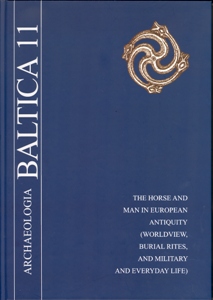Volume 11 (2009): The Horse and Man in European Antiquity (Worldview, Burial Rites, and Military and Everyday Life), August 2009

Order by:
Pub. online: 30 Aug 2009
Type: Article
 Open Access
Open Access
Journal:
Archaeologia Baltica
Volume 11 (2009): The Horse and Man in European Antiquity (Worldview, Burial Rites, and Military and Everyday Life), pp. 283–294
Abstract
Pub. online: 30 Aug 2009
Type: Article
 Open Access
Open Access
Journal:
Archaeologia Baltica
Volume 11 (2009): The Horse and Man in European Antiquity (Worldview, Burial Rites, and Military and Everyday Life), pp. 295–304
Abstract
Pub. online: 30 Aug 2009
Type: Article
 Open Access
Open Access
Journal:
Archaeologia Baltica
Volume 11 (2009): The Horse and Man in European Antiquity (Worldview, Burial Rites, and Military and Everyday Life), pp. 305–313
Abstract
Pub. online: 30 Aug 2009
Type: Article
 Open Access
Open Access
Journal:
Archaeologia Baltica
Volume 11 (2009): The Horse and Man in European Antiquity (Worldview, Burial Rites, and Military and Everyday Life), pp. 314–327
Abstract
Pub. online: 30 Aug 2009
Type: Article
 Open Access
Open Access
Journal:
Archaeologia Baltica
Volume 11 (2009): The Horse and Man in European Antiquity (Worldview, Burial Rites, and Military and Everyday Life), pp. 330–342
Abstract
Pub. online: 30 Aug 2009
Type: Article
 Open Access
Open Access
Journal:
Archaeologia Baltica
Volume 11 (2009): The Horse and Man in European Antiquity (Worldview, Burial Rites, and Military and Everyday Life), pp. 343–346
Abstract
Pub. online: 30 Aug 2009
Type: Article
 Open Access
Open Access
Journal:
Archaeologia Baltica
Volume 11 (2009): The Horse and Man in European Antiquity (Worldview, Burial Rites, and Military and Everyday Life), pp. 350–356
Abstract
Pub. online: 30 Aug 2009
Type: Article
 Open Access
Open Access
Journal:
Archaeologia Baltica
Volume 11 (2009): The Horse and Man in European Antiquity (Worldview, Burial Rites, and Military and Everyday Life), pp. 357–363
Abstract
Pub. online: 30 Aug 2009
Type: Article
 Open Access
Open Access
Journal:
Archaeologia Baltica
Volume 11 (2009): The Horse and Man in European Antiquity (Worldview, Burial Rites, and Military and Everyday Life), pp. 364–373
Abstract
Pub. online: 30 Aug 2009
Type: Plates
 Open Access
Open Access
Journal:
Archaeologia Baltica
Volume 11 (2009): The Horse and Man in European Antiquity (Worldview, Burial Rites, and Military and Everyday Life), p. 374